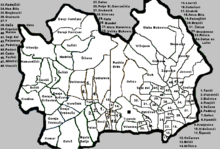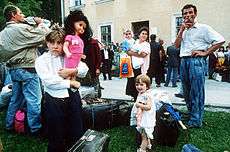Travnik
| Travnik Травник | ||
|---|---|---|
| Town and Municipality | ||
.jpg) | ||
| ||
 Location of Travnik within Bosnia and Herzegovina. | ||
| Coordinates: 44°13′35″N 17°39′35″E / 44.22639°N 17.65972°ECoordinates: 44°13′35″N 17°39′35″E / 44.22639°N 17.65972°E | ||
| Country | Bosnia and Herzegovina | |
| Canton | Central Bosnia | |
| Government | ||
| • Municipality president | Admir Hadžiemrić (SDA) | |
| Area | ||
| • Town and Municipality | 529 km2 (204 sq mi) | |
| Elevation | 514 m (1,686 ft) | |
| Population (2013 census) | ||
| • Town and Municipality | 16,534 | |
| • Density | 109/km2 (280/sq mi) | |
| • Urban | 57,543 | |
| Time zone | CET (UTC+1) | |
| • Summer (DST) | CEST (UTC+2) | |
| Postal code | 72270 | |
| Area code(s) | (+387) 30 | |
| Website |
www | |
| Wikimedia Commons has media related to Travnik. |
Travnik (Bosnian pronunciation: [trâːʋniːk]) is a town and municipality in central Bosnia and Herzegovina, 90 kilometres (56 miles) west of Sarajevo. It is the capital of the Central Bosnia Canton, and is located in the Travnik Municipality. Travnik town had 16,534 residents in 2013, with a municipality population that of 57,543 people. It was the capital city of the governors of Bosnia from 1699 to 1850, and has a cultural heritage dating from that period.[1]
Geography
Travnik is located near the geographic center of Bosnia and Herzegovina at 44°14′N 17°40′E / 44.233°N 17.667°E. The river Lašva passes through the city, flowing from west to east before joining the Bosna. Travnik itself is built in the large Lašva valley, which connects the Bosna river valley in the east with the Vrbas river valley in the west.
Travnik is found 514 metres (1,686 feet) above sea level. Its most distinguishing geographic feature are its mountains, Vilenica and Vlašić. Vlašić, named after the Vlachs, is one of the tallest mountains in the country at 1,933 metres (6,342 feet).
Climate
Travnik has a continental climate, located between the Adriatic sea to the South and Pannonia to the North. Average summer temperature is 18.2 °C (64.8 °F). Average winter temperature on the other hand is a cold 0.5 °C (32.9 °F). It snows in Travnik every year.
History
Although there is evidence of some settlement in the region dating back to the Bronze Age, the true history of Travnik begins during the first few centuries AD. Dating from this time there are numerous indications of Roman settlement in the region, including graves, forts, the remains of various other structures, early Christian basilicas, etc. In the city itself, Roman coins and plaques have been found. Some writing found indicates the settlement is closely connected to the known Roman colony in modern-day Zenica, 30 km (19 mi) away.
In the Middle Ages the Travnik area was known as the župa Lašva province of the medieval Bosnian Kingdom. The area is first mentioned by Bela IV of Hungary in 1244. Travnik itself was one of a number of fortified towns in the region, with its fortress Kaštel becoming today's old town sector. The city itself is first mentioned by the Ottomans during their conquest of nearby Jajce.
After the Ottoman conquest of Bosnia in the 15th century, much of the local population converted to Islam. The city quickly grew into one of the more important settlements in the region, as authorities constructed mosques, marketplaces, and various infrastructure. During 1699 when Sarajevo was set afire by soldiers of Field-Marshal Prince Eugene of Savoy, Travnik became the capital of the Ottoman province of Bosnia and residence of the Bosnian viziers. The city became an important center of government in the whole Western frontier of the empire, and consulates were established by the governments of France and Austria-Hungary.
The period of Austrian occupation brought westernization and industry to Travnik, but also a reduction of importance. While cities such as Banja Luka, Sarajevo, Tuzla, and Zenica grew rapidly, Travnik changed so little that during 1991 it had a mere 30,000 or so people, with 70,000 in the entire municipality.
A large fire started by a spark from a locomotive in September 1903 destroyed most of the towns buildings and homes, leaving only some hamlets and the fortress untouched.[2] The cleanup and rebuilding took several years.[3]
From 1929 to 1941, Travnik was part of the Drina Banovina of the Kingdom of Yugoslavia.
During the Bosnian War, the town mostly escaped damage from conflict with Serbian forces, hosting refugees from nearby Jajce, but the area experienced fighting between local Bosniak and Croat factions before the Washington Agreement was signed in 1994. After the war, Travnik was made the capital of the Central Bosnia Canton.
Administration


The town of Travnik is the administrative centre of the Travnik Municipality, whose area of jurisdiction covers Travnik and the outlying villages and small towns. Travnik is also the capital of the Central Bosnia Canton, one of the ten Cantons of Bosnia. The municipality government has various bureau's dedicated to help in the running of the region, ranging from the bureau of urbanization and construction, to the bureau of refugees and displaced persons.
Economy
The economy of the Travnik region, which was never anything extraordinary, suffered greatly during the war period of the early 1990s. In 1981 Travnik's GDP per capita was 63% of the Yugoslav average.[4] Nowadays, most of the region deals with typical rural work such as farming and herding. As for urban industry, Travnik has several factories producing everything from matches to furniture. Food processing is also a strong industry in the region, especially meat and milk companies.
Tourism
.jpg)
Like many Bosnian towns, Travnik's tourism is based largely on its history and geography. Nearby Mt.Vlašić is one of the tallest peaks in Bosnia and Herzegovina, and an excellent spot for skiing, hiking, and sledding. Though tourism isn't very strong for the city, Vlašić is probably its chief tourist attraction. The city itself is also of interest. Numerous structures dating to the Ottoman era have survived in near perfect condition, such as numerous mosques, oriental homes, two clock towers (sahat kula; Travnik is the only city in Bosnia and Herzegovina to have two clock towers), and fountains. The city's old town dates back to the early 15th century, making it one of the most popular widely accessible sites from that time.
Demographics

1971
55,822 total
- Bosniaks – 24,480 (43.85%)
- Croats – 22,645 (40.56%)
- Serbs – 7,554 (13.53%)
- Yugoslavs – 626 (1.12%)
- others – 517 (0.94%)
- Turks - 10
1991
According to the 1991 Yugoslav census, the area had a population of 70,747. Of these, 31,813 were Bosniaks (45%), 26,118 were Croats (37%), 7,777 were Serbs (11%), 3,743 were Yugoslavs (5%) and 1,296 "others" (2%).
Within town itself Travnik had a population of 19,041. Of these, 7,373 were Bosniaks (39%), 6,043 were Croats (32%), 2,131 were Serbs (12%), 2,800 were Yugoslavs (14%) and 694 "others" (4%).
2013
[5] 53,482 total
- Bosniaks – 35,648 (66.65%)
- Croats – 15,102 (28.23%)
- Serbs – 640 (1.19%)
- not declared – 327 (0.61%)
- others – 1628 (3.04%)
- no answer - 137 (0.25%)
Culture

Travnik has a strong culture, mostly dating back to its time as the center of local government in the Ottoman Empire. Travnik has a popular old town district however, which dates back to the period of Bosnian independence during the first half of the 15th century. Numerous mosques and churches exist in the region, as do tombs of important historical figures and excellent examples of Ottoman architecture. The city museum, built in 1950, is one of the more impressive cultural institutions in the region.
Travnik became famous by important persons who were born or lived in the city. The most important of which are Ivo Andrić (writer, Nobel Prize for literature in 1961), Miroslav Ćiro Blažević (football coach of Croatian national team, won third place 1998 in France), Josip Pejaković (actor), Seid Memić (pop-singer) and Davor Džalto (artist and art historian, the youngest PhD in Germany and in the South-East European region).
One of the main works of Ivo Andrić, himself a native of Travnik, is the Bosnian Chronicle (or Travnik Chronicle),[6] depicting life in Travnik during the Napoleonic Wars and itself written during World War II. In this work Travnik and its people - with their variety of ethnic and religious communities - are described with a mixture of affection and exasperation.
The Bosnian Tornjak, one of Bosnia's two major dog breeds and national symbol, originated in the area, found around Vlašić mountain.
Sport
The local football team is NK Travnik, established in 1922.
Notable people
- Ivo Andrić, writer and the 1961 winner of the Nobel Prize for literature
- Zoran Đinđić, philosopher, politician, Prime Minister of Serbia
- Josip and Zlatko Pejaković, artist brothers, actor and musicians
- Davor Džalto, artist, art historian, theologian and philosopher
- Vjekoslav Kramer, chef
- Sena Jurinac, operatic soprano
- Solomon Gaon, Sephardic Rabbi and Hakham
- Mirosław Ferić, fighter pilot
- Nikola Mandić, politician
- Zlata Bartl, scientist and is the creator of Vegeta
- Frano Zubić, Bosnian Franciscan
- Larisa Cerić, judoka and European Championship silver medalist
Twin cities
 Leipzig, Germany
Leipzig, Germany Kruševac, Serbia
Kruševac, Serbia Gornji Milanovac, Serbia
Gornji Milanovac, Serbia
Gallery
- Suleimania Mosque
 Suleimania Mosque
Suleimania Mosque- Suleimania Mosque
- Suleimania Mosque
- Sahat Kula, Clock Tower
- Another Clock Tower
- View from Travnik Castle
- Entrance to Travnik
 Birthplace (home) of Ivo Andrić
Birthplace (home) of Ivo Andrić Poturmahala.
Poturmahala. Old Town
Old Town
References
- ↑ http://www.ovguide.com/travnik-9202a8c04000641f8000000000328e74
- ↑ Bosnia and Herzegovina; page 243. Google Books. 2013. Retrieved 20 October 2014.
- ↑ A British Officer in the Balkans; page 196. Google Books. 1909. Retrieved 20 October 2014.
- ↑ Radovinović, Radovan; Bertić, Ivan, eds. (1984). Atlas svijeta: Novi pogled na Zemlju (in Croatian) (3rd ed.). Zagreb: Sveučilišna naklada Liber.
- ↑ http://www.popis2013.ba/popis2013/doc/Popis2013prvoIzdanje.pdf
- ↑ "Bosnian Chronicle". Ivoandric.org.rs. Retrieved 15 June 2011.
External links
- http://www.fzf.ba
- http://www.opcinatravnik.com.ba
- Dnevnik srednje bosne
- Internacionalni Univerzitet Travnik
- Information about city
- Travnik — A city guide (English)
- http://www.novitravnik.info
- http://www.eko-fis.com.ba
- http://www.unsa.ba
